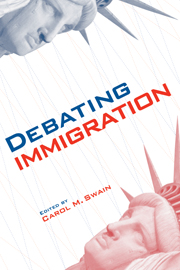Book contents
- Frontmatter
- Contents
- About the Contributors
- Preface
- Acknowledgments
- 1 Introduction
- PART I PHILOSOPHY AND RELIGION
- PART II LAW AND POLICY
- PART III ECONOMICS AND DEMOGRAPHICS
- PART IV RACE
- PART V COSMOPOLITANISM
- 16 The Free Economy and the Jacobin State, or How Europe Can Cope with the Coming Immigration Wave
- 17 The Politics of Immigration and Citizenship in Europe
- PART VI CONCLUSION
- Notes
- Index
17 - The Politics of Immigration and Citizenship in Europe
Published online by Cambridge University Press: 05 June 2012
- Frontmatter
- Contents
- About the Contributors
- Preface
- Acknowledgments
- 1 Introduction
- PART I PHILOSOPHY AND RELIGION
- PART II LAW AND POLICY
- PART III ECONOMICS AND DEMOGRAPHICS
- PART IV RACE
- PART V COSMOPOLITANISM
- 16 The Free Economy and the Jacobin State, or How Europe Can Cope with the Coming Immigration Wave
- 17 The Politics of Immigration and Citizenship in Europe
- PART VI CONCLUSION
- Notes
- Index
Summary
In historical and comparative perspective, immigration and citizenship have been viewed as two of the main features that distinguish the United States from the countries of Europe. The United States, along with Australia and Canada, has typically been considered a “settler” country, with very open and generous policies for the admittance and integration of immigrants. Most European countries, in contrast, have been very conflicted about having immigrants in their midst, and their policies have been relatively restrictive in comparison with those of the United States. But in the postwar period, the growing need for unskilled labor brought about unprecedented levels of immigration in much of Europe, leading to two distinct types of national strategies: former colonial powers (such as the United Kingdom, France, and the Netherlands) began to allow large and increasing numbers of people from their former colonies to immigrate and become citizens, while other countries (such as Germany or Austria) implemented “guestworker” models, through which many ostensibly temporary workers were imported in the 1950s and 1960s without being encouraged to integrate, bring their families, or “settle” into their host societies.
While this two-type categorization of European immigration responses did fit much of the second half of the 20th century quite well, it has considerably less utility today. Indeed, almost all of the 15 “older” countries of the European Union (EU) – regardless of their earlier model – are confronting a new reality, namely that their societies include significant minorities (usually 5–10 percent of the population, and much higher percentages in cities) of immigrant origin, who have the intention, and the right, as enshrined in national and European law, to stay permanently.
- Type
- Chapter
- Information
- Debating Immigration , pp. 237 - 254Publisher: Cambridge University PressPrint publication year: 2007
- 2
- Cited by



